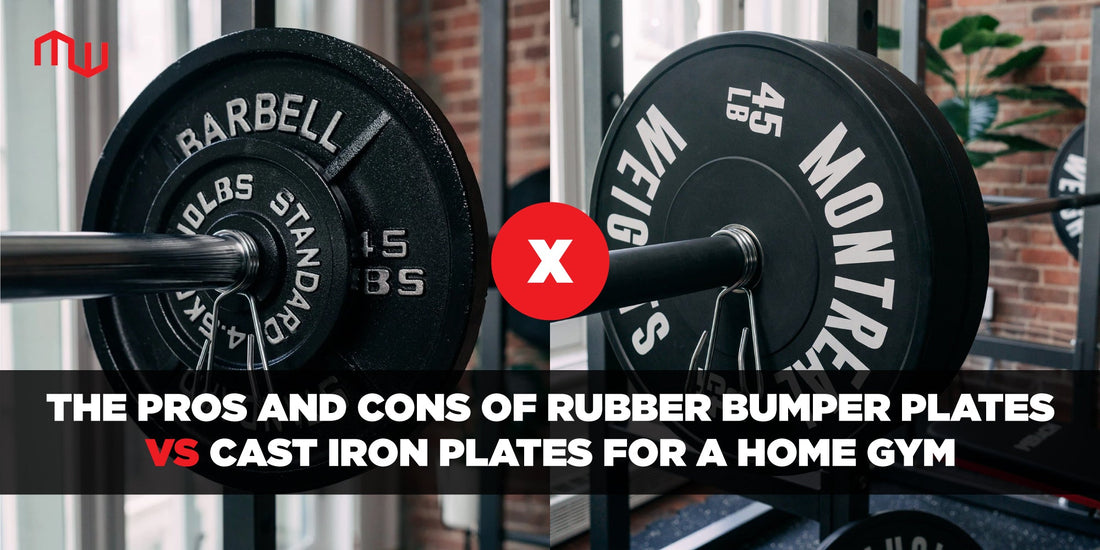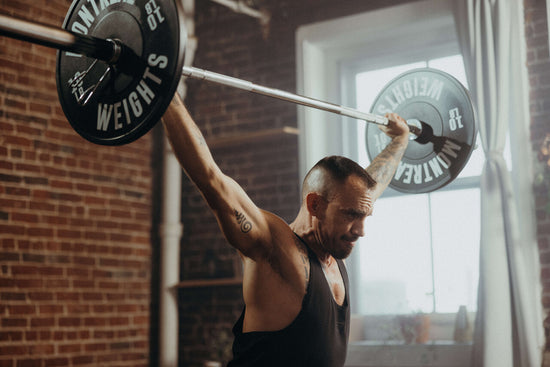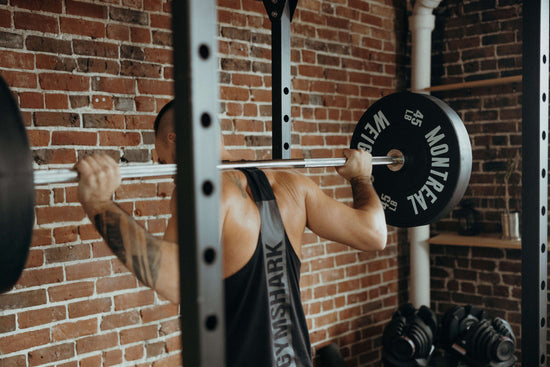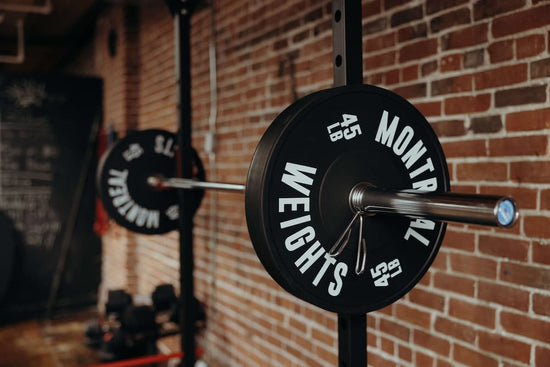
Introduction
When it comes to setting up a home gym, one important consideration is the type of weight plates to use. Rubber bumper plates and cast iron plates are two popular options among fitness enthusiasts. Each type has its own set of advantages and disadvantages. In this article, we will help you make an informed decision for your home exercise equipment by examining the pros and cons of rubber bumper plates and cast iron plates.
Rubber bumper plates excel in safety, floor protection, noise reduction, and weight variability, but they come at a higher price.
Cast iron plates offer affordability, weight accuracy, stability, and durability, but they lack the cushioning effect and can be noisier.
the choice depends on the type of exercises you plan to perform, your budget, and your tolerance for noise.
Rubber Bumper Plates
What are Rubber Bumper Plates?
Rubber Bumper Plates are weight plates made of solid rubber material. They are designed to be dropped overhead during weightlifting exercises, providing cushioning and reducing the risk of damaging the barbell, floor and surrounding equipment.
Pros of Rubber Bumper Plates
- Safety: Rubber Bumper Plates are excellent for Olympic weightlifting and functional fitness exercises that involve dropping weights. The risk of injury and equipment damage is minimized because the rubber construction absorbs the impact.
- Floor Protection: The rubber material protects the floor from dents, scratches and other forms of damage. This is especially beneficial if you have a home gym with sensitive floors.
- Noise Reduction: Rubber bumper plates produce less noise when dropped compared to cast iron plates. This is advantageous if you have neighbors or want a quieter workout environment.
- Weight Variability: Bumper plates are available in a wide range of weights, allowing for more precise load adjustments during workouts.
Cons of Rubber Bumper Plates
- Price: Rubber bumper plates tend to be more expensive than cast iron plates. The cost can be a significant factor if you are on a tight budget.
- Bounce Effect: The cushioning properties of rubber can cause a slight bounce when the plates hit the ground. This may affect the stability of the barbell during certain lifts, requiring extra control from the lifter.
Cast Iron Plates
What are Cast Iron Plates?
Cast iron plates are weight plates made of solid cast iron material. They are the traditional choice for weightlifting and strength training exercises.
Pros of Cast Iron Plates
- Affordability: Cast iron plates are generally more affordable than rubber bumper plates, making them a cost-effective option for home gyms.
- Weight Accuracy: Cast iron plates tend to have a higher weight accuracy compared to rubber bumper plates. This is important for lifters who require precise weight increments.
- Stability: The solid construction of cast iron plates provides excellent stability during lifts, minimizing any potential barbell movement.
Cons of Cast Iron Plates
- Noise and Floor Damage: Cast iron plates produce more noise when dropped, and they have the potential to damage the floor if not handled properly.
- Lack of Bounce: Unlike rubber bumper plates, cast iron plates do not offer any cushioning effect. This can be a disadvantage for exercises that involve dropping the weights or performing explosive movements.
Comparison
Weight Accuracy and Durability
Cast iron plates are known for their weight accuracy, which is important for progressive training and precise load adjustments. On the other hand, rubber bumper plates may have slight weight deviations due to their manufacturing process.
In terms of durability, cast iron plates are highly resistant to wear and tear and can withstand heavy use over an extended period. Rubber bumper plates, while durable, may show signs of wear and tear over time, especially if frequently dropped from overhead.
Noise and Floor Protection
Rubber bumper plates have the advantage of reducing noise levels when dropped, making them more suitable for home gym setups where noise control is important. They also provide better floor protection, preventing damage to the floor surface.
Cast iron plates, however, tend to produce more noise when dropped and have the potential to cause damage to the floor if not carefully handled or used with appropriate protective mats.
Price and Availability
Cast iron plates are generally more affordable compared to rubber bumper plates, which can be a significant consideration for individuals on a limited budget. Cast iron plates are also widely available and can be purchased from various fitness equipment retailers.
Rubber bumper plates, while more expensive, offer additional safety features and are commonly found in gyms and fitness facilities that focus on Olympic weightlifting and functional fitness training.
Performance and Versatility
Rubber bumper plates are specifically designed for exercises that involve dropping the weights, such as Olympic lifts and CrossFit workouts. Their cushioning effect and shock absorption properties make them ideal for these types of activities.
Cast iron plates, on the other hand, are well-suited for traditional weightlifting and strength training exercises. They provide stability and do not have a bounce effect, making them suitable for exercises that require a steady grip and controlled movements.
Conclusion
It's important to consider your specific needs and preferences when choosing between rubber bumper plates and cast iron plates for your home gym. Rubber bumper plates excel in safety, floor protection, noise reduction and weight variability. However, they come at a higher price. Cast iron plates offer affordability, weight accuracy, stability and durability, but they lack cushioning and can be noisier.
Ultimately, which option you choose depends on the exercises you plan to perform, your budget, and how you tolerate noise. It's important to weigh these factors carefully before making a decision, as both options have their pros and cons.
At Montreal Weights, we understand the importance of providing our customers with a diverse range of options to meet their powerlifting needs. That's why we proudly offer an affordable selection of both bumper plates and cast iron plates in our extensive powerlifting collection.
FAQs
Can I mix rubber bumper plates with cast iron plates on the same barbell?
Yes, it is possible to mix rubber bumper plates with cast iron plates on the same barbell. However, it's important to ensure that the total weight capacity of the barbell is not exceeded and that the plates are securely fastened to the barbell sleeves.
Are rubber bumper plates suitable for powerlifting exercises?
While rubber bumper plates can be used for powerlifting exercises, they are more commonly used for Olympic weightlifting and functional fitness training. Powerlifting typically involves slower, controlled movements where the cushioning effect of bumper plates may not be necessary.
Do rubber bumper plates have a standard diameter?
Yes, rubber bumper plates typically have a standardized diameter of 450mm. This ensures that the barbell height remains consistent, regardless of the weight loaded on the bar.
Can cast iron plates damage the floor in a home gym?
Cast iron plates have the potential to damage the floor if dropped or dragged without proper protection. It is advisable to use appropriate protective mats or flooring to prevent any floor damage.
Which type of weight plates should I choose for general fitness training?
For general fitness training, both rubber bumper plates and cast iron plates can be suitable options. Consider factors such as price, noise level, floor protection, and personal preferences to make an informed decision based on your specific needs.





